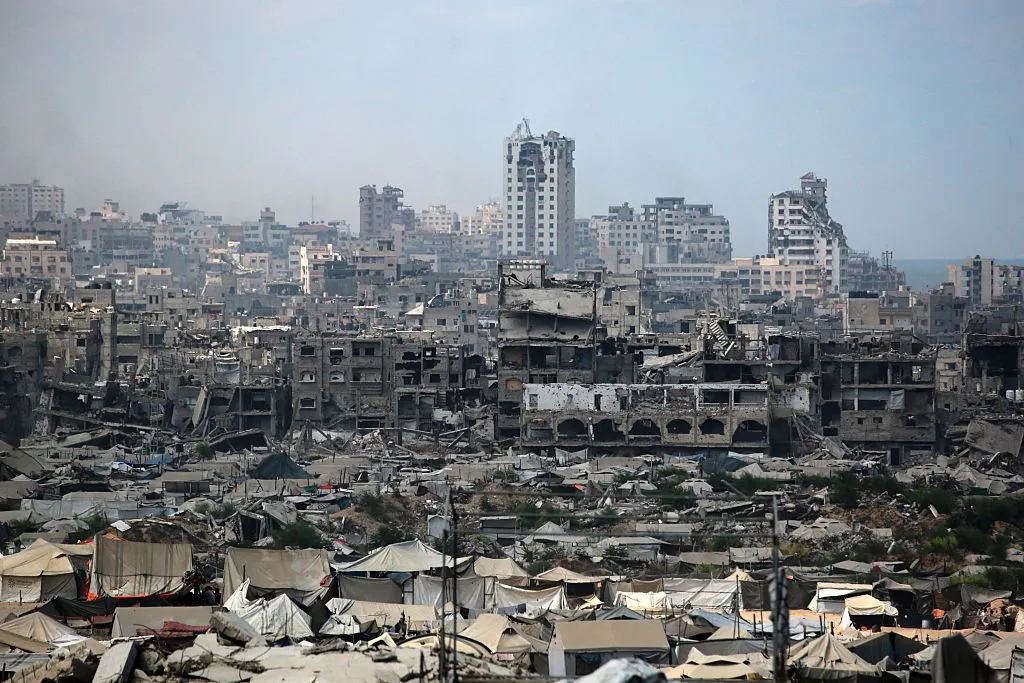European and Middle Eastern leaders have expressed support for a new US-backed Gaza peace plan, unveiled by President Donald Trump and Israeli Prime Minister Benjamin Netanyahu.
The proposal, described by Trump as “a historic day for peace,” outlines a 20-point framework aimed at ending months of war, securing the release of hostages, and setting conditions for Gaza’s future governance.
Key Elements of Trump’s Gaza Peace Plan
At its core, the plan calls for an immediate ceasefire between Israel and Hamas.
Within 72 hours, Hamas would release 20 living Israeli hostages as well as the remains of more than two dozen others believed to be dead, in exchange for hundreds of detained Palestinians.
For every Israeli hostage whose remains are returned, Israel would release the remains of 15 Palestinians.
How Would the Full Humanitarian Aid Enter Gaza?
Gaza peace plan also requires Hamas to lay down its arms, dismantle its tunnels, and shut down its weapons production facilities.
In return, full humanitarian aid would be allowed into Gaza immediately.
On governance, the plan stipulates that Hamas will have no role in running Gaza “directly, indirectly, or in any form.”
Instead, a temporary technocratic Palestinian committee would oversee the territory under the supervision of an international transitional body called the Board of Peace, headed by Trump himself.
Former UK Prime Minister Tony Blair will be among its members.
Read also: Day 724 of Gaza War: Trump Expresses Optimism Amid Devastating Chaos
Mixed Messages from Netanyahu
While the White House proposal leaves the door open to an eventual Palestinian state, Netanyahu quickly reiterated his long-standing opposition.
In a video statement, he stressed: “It’s not written in the agreement.
We said we would strongly oppose a Palestinian state.”
He also insisted the Israel Defense Forces (IDF) would remain in Gaza, contradicting the US text that states Israeli forces will gradually withdraw.
Netanyahu added that if Hamas rejected the deal, Israel would “finish the job of destroying the threat of Hamas” with full US support.
Regional and International Reactions on Gaza Peace Plan
Despite these contradictions, many governments welcomed Gaza Peace Plan.
The Palestinian Authority (PA), which governs parts of the West Bank, praised Trump’s “sincere and determined” efforts and expressed readiness to work with Washington, regional states, and international partners to end the conflict and facilitate humanitarian aid.
In a joint statement, the foreign ministers of Saudi Arabia, Qatar, the UAE, Egypt, Jordan, Turkey, Indonesia, and Pakistan also expressed support, saying they were ready to engage with the US to finalize and implement the agreement.
They emphasized that the plan should lead to a two-state solution in which Gaza is fully integrated with the West Bank.
Europe Wants Peace in Gaza
European leaders echoed this sentiment.
European Council President Antonio Costa said he was “encouraged by Netanyahu’s positive response,” urging all parties to seize the moment.
French President Emmanuel Macron declared that France “stands ready to contribute,” while Italy’s Prime Minister Giorgia Meloni described the plan as a potential turning point.
UK Prime Minister Sir Keir Starmer called on Hamas to agree to the proposal and “end the misery” by releasing hostages.
Hamas Response and Ongoing Challenges
Hamas leaders, based in Doha, confirmed receiving the plan through Qatari and Egyptian mediators.
A senior Hamas official told the BBC that the group remains open to reviewing proposals but stressed that any agreement must guarantee a full Israeli withdrawal, safeguard Palestinian interests, and support an independent Palestinian state based on 1967 borders.
He added that Hamas would not surrender its weapons while “the occupation continues.”
The announcement of the peace plan comes amid heightened tensions.
Netanyahu recently condemned European recognition of a Palestinian state, calling it a “mark of shame.” His speech at the UN triggered a mass walk-out by diplomats, highlighting growing divisions between Israel and Western allies.
66,000 Palestinians Were Killed
Meanwhile, the humanitarian crisis in Gaza continues to deepen.
According to Hamas-run health ministry, more than 66,000 Palestinians have been killed since Israel’s military campaign began in October 2023, launched after Hamas’s attack that killed 1,200 Israelis and took 251 hostages.
A UN-backed body has confirmed famine conditions in Gaza City, and a UN commission of inquiry recently accused Israel of genocide—charges Israel strongly rejects.
US Gaza Peace Plan: A Fragile Path Forward
Trump’s Gaza peace plan has drawn rare global alignment, with both Middle Eastern and European powers welcoming US leadership.
However, deep disagreements remain between Hamas, Israel, and other stakeholders on governance, security, and the future Palestinian state.
Whether the plan can move from proposal to reality depends on Hamas’s response, Netanyahu’s willingness to compromise, and the international community’s ability to enforce its terms.
For now, the initiative offers a fragile but critical opportunity to halt the violence and lay the groundwork for lasting peace in Gaza.


